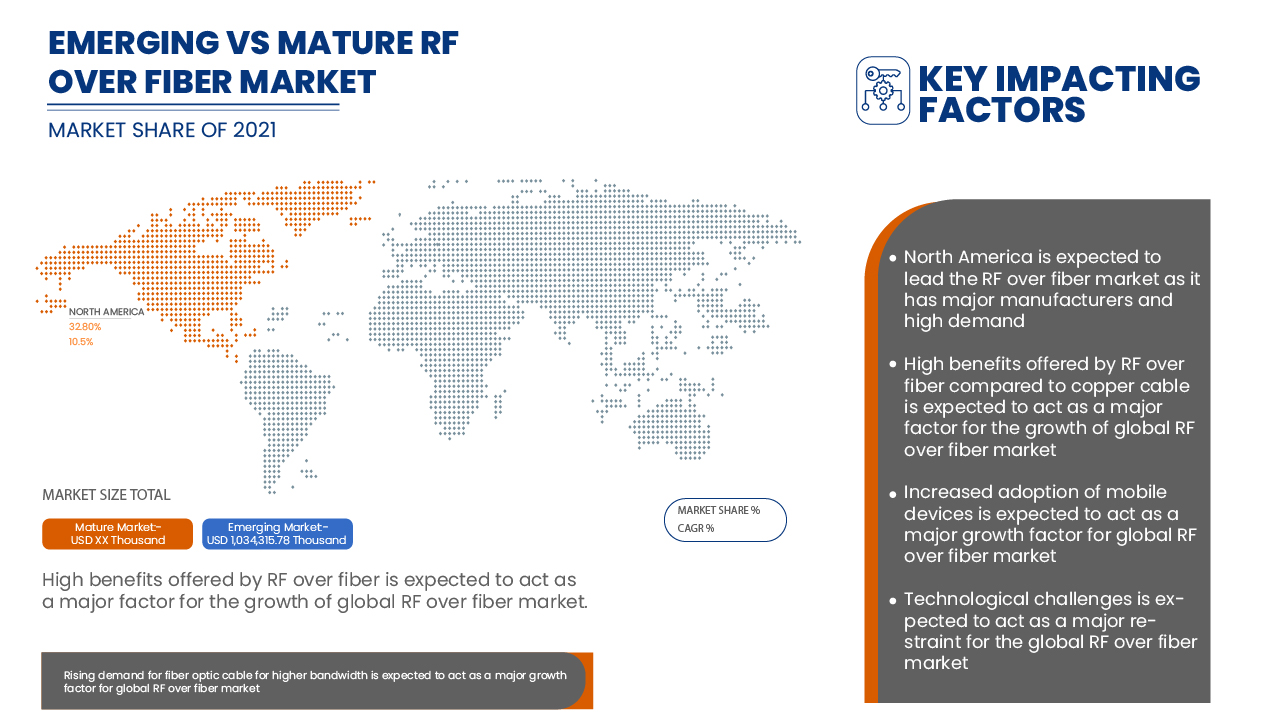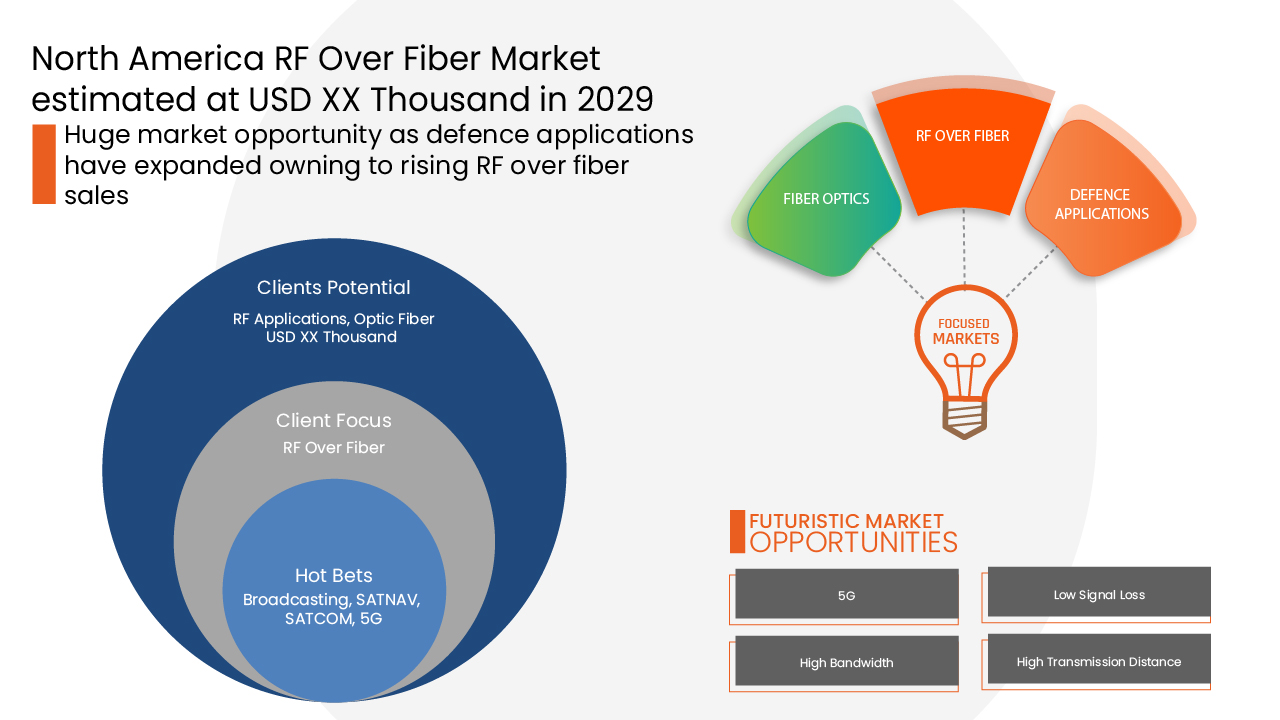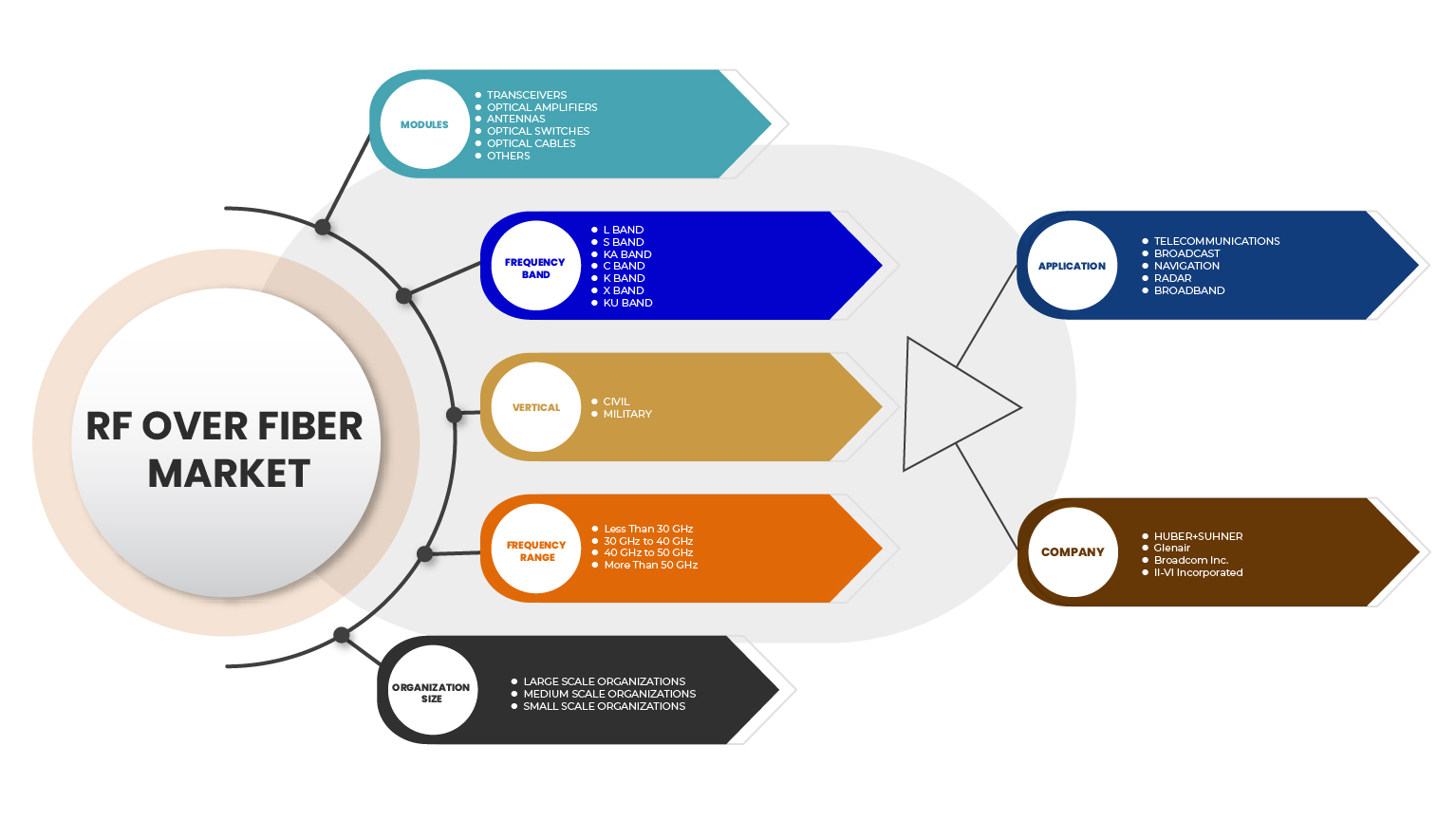
Market Analysis and Size
Technological development brought the enhanced internet service to support the consumer demand for faster internet connection, augmenting the increased count of fiber optic networks. This has been made possible as the population is getting more inclined towards digital platforms, internet services, and online services for their daily requirements. This increasing internet penetration is creating a huge demand for high bandwidth, high-speed internet services that are efficiently provided by the fiber-optic network. Thus, the increasing growth in fiber optic infrastructure increases the demand for RF over fiber.


The major factor driving the market's growth is consumers' increasing demand for high-definition content. The high bandwidth offered by fiber-optic networks is a major factor in boosting the North America RF over fiber market. However, the high initial cost required for building the infrastructure may restrain the market's growth.
Data Bridge Market Research analyses that the North America RF over fiber market is expected to reach the value of USD 349,256.63 thousand by 2029, at a CAGR of 10.5% during the forecast period. "Transceiver" accounts for the most prominent modules mode segment. The North America RF over fiber market report also covers pricing analysis, patent analysis, and technological advancements in depth.
|
Report Metric |
Details |
|
Forecast Period |
2022 to 2029 |
|
Base Year |
2021 |
|
Historic Years |
2020 (Customizable to 2019-2014) |
|
Quantitative Units |
Revenue in USD Thousand, Pricing in USD |
|
Segments Covered |
Modules (Transceivers, Optical Amplifiers, Antennas, Optical Switches, Optical Cables, and Others), Frequency Band (L Band, S Band, Ka Band, C Band, K Band, X Band, and Ku Band), Vertical (Civil and Military), Frequency Range (Less Than 30 GHz, 30 GHz to 40 GHz, 40 GHz to 50 GHz and More Than 50 GHz), Organization Size (Large Scale Organization, Medium Scale Organization, and Small Scale Organization), Application (Telecommunications, Broadcast, Navigation, Radar And Broadband) |
|
Countries Covered |
U.S., Canada, Mexico |
|
Market Players Covered |
Broadcom, EMCORE Corporation, APIC Corporation, Optical Zonu Corp, Gooch & Housego PLC, ViaLite, Global Invacom, HUBER+SUHNER, Glenair, SEIKOH GIKEN CO., LTD., II-VI Incorporated, DEV Systemtechnik GmbH, Octane Wireless, Syntonics LLC, Intelibs, Inc., ETL Systems Ltd, Narda-MITEQ, RFOptic Ltd., Elkay, MicroComp Nordic AB, Microwave Photonic Systems, Inc., among others |
Market Definition
Radio over fiber (RF over fiber) is an analog transmission over fiber technology that uses a radio signal to amplitude modulate light and transport it over an optical fiber link to enable wireless access. Although radio transmission over fiber is utilized for various applications, including cable television (CATV) networks and satellite base stations, the term RoF is most commonly associated with wireless access. Wireless signals are transferred in optical form between a central station and a group of base stations in RoF systems before being broadcast. Each base station is configured to communicate with at least one user's mobile station within the base station's radio range.
North America RF Over Fiber Market Dynamics
This section deals with understanding the market drivers, advantages, opportunities, restraints, and challenges. All of this is discussed in detail below:
- Rising demand for fiber optic cable for higher bandwidth
Fiber optic bandwidth is high as data transmission speed and distance covered data without attenuation are possible. Optical fiber can transmit data as pulses of light through different objects such as glass wire, allowing data to travel at the speed of light. Optical communication helps a beam of light to carry information from transmitter to receiver. Optical frequency is usually close to an infrared ray and about one thousand GHz. Fiber optics provide the network with the utmost quality data and little signal interference.
- Efficient performance of fiber optic cable as compared to copper cable
Copper cable bandwidth is restricted in terms of speed and frequencies. The range of frequencies over which data are transmitted is much wider in optical fiber. Fiber can carry far more information in minutes from one area to another while the copper cable transmits data slowly, using electrical signals than optical fiber, which carries data through light-based signals.
- Increased adoption of mobile devices
The increasing disposable income of the consumers and the need for advanced electronic products are driving the consumer electronics market. Consumers are becoming techno-savvy and adopting new technologies at work, in daily routine, in personal entertainment, and others. Smart devices are adopting a major share of the market due to improved control, features, and other functions.
- Low power consumption benefit of RFoF
The energy required per bit of data conveyed can also determine a system's energy efficiency. The power consumption can be defined as the power consumption per user vs the average access rate (Watts/Mbps), and the power consumption of an access network infrastructure is created using network segmentation. Manufacturer data on equipment energy consumption for a variety of typical types of hardware is used to calculate the energy consumption of each portion of the system for a range of access rates. This perspective provides a better platform for predicting the rise in power consumption as the number of users and access rate per user grows fast.
- Easy installation and maintenance of RFoF
Most RoF techniques eliminate the necessity for local oscillators and related equipment at the Remote Antenna Units (RAU). The complex and expensive equipment is maintained at the head end of RoF systems, making RAUs simpler. The high-frequency electro-optical modulators and electronics must be avoided at the CS (central station) due to their high cost and high power consumption. In addition, due to their high production and maintenance costs, sophisticated implementations of downlink transmission systems should also be avoided. The head end houses the modulation and switching equipment, which several RAUs share. As a result of this configuration, RAUs are smaller and lighter, lowering system installation and maintenance costs.
- Technological limitation of RFoF
Chromatic dispersion in single-mode fiber based RoF systems can limit fiber connection lengths and cause phase de-correlation, resulting in higher RF carrier phase noise. Modal dispersion severely limits the available link bandwidth and distance in multi-mode fiber-based RoF systems. Although the RoF transmission method is analog, the radio system that is distributed does not have to be analog (e.g., WLAN and UMTS) and can use extensive multi-level signal modulation formats such as Quadrature Amplitude Modulation (QAM) or orthogonal frequency division multiplexing (OFDM).
- High initial cost of investment
RF over fiber network offers several beneficial factors such as high bandwidth, high speed, and lightweight, but all this comes with a high investment cost. The fiber optic network components are quite expensive. This is why copper cables are still preferred, where cost is a major factor in choosing the type of network. This may restrain the growth of the North America RF over fiber market. Adding the cost of transceivers and all other components increase the overall costs, leading to high investment costs by the company. The telecom industries prefer using copper cable infrastructure for end-users due to its low cost.
Post COVID-19 Impact on North America RF Over Fiber Market
COVID-19 created a major impact on the North America RF over fiber market as almost every country has opted for the shutdown of every production facility except those dealing in producing the essential goods. The government has taken strict actions such as the shutdown of production and sale of non-essential goods, blocked international trade, and many more to prevent the spread of COVID-19. The only business dealing with this pandemic is the essential services allowed to open and run the processes.
The growth of the North America RF over fiber market is rising due to the government policies to boost international trade post covid. Also, the benefits offered by RF over fiber for optimizing costs and routes are raising the demand for RF over fiber in the market. However, factors such as congestion associated with trade routes and trade restrictions between some nations are restraining the market growth. The shutdown of production facilities during the pandemic has had a significant impact on the market.
Manufacturers are making various strategic decisions to bounce back post-COVID-19. The players are conducting multiple research and development activities to improve the technology involved in the RF over fiber. With this, the companies will bring advanced and accurate solutions to the market. In addition, the government initiatives to boost international trade have led to the market's growth.
Recent Developments
- In March 2022, Broadcom Inc. announced the demonstration of its 100G/lane optical PAM-4 DSP PHY with an integrated trans-impedance amplifier (TIA) and high-swing laser driver. It is built on a 112G PAM-4 DSP platform, which provides the highest level of CMOS integration and superior performance with lower power consumption. Thus, the company will be able to expand its product portfolio in the market
- In November 2021, HUBER+SUHNER launched Rail Antenna, which can boost 4G and 5G connectivity. This new SENCITY Rail MIMO+ Rooftop antenna increases potential 4G and 5G data throughout trains using advanced dual-polarization antenna technology. With this, the company will be able to expand its product portfolio in the market
North America RF Over Fiber Market Scope
North America RF over fiber market is segmented on the basis of modules, frequency band, vertical, frequency range, and application. The growth amongst these segments will help you analyze meager growth segments in the industries and provide the users with a valuable market overview and market insights to help them make strategic decisions for identifying core market applications.
By Modules
- Transceivers
- Optical Amplifiers
- Antennas
- Optical Switches
- Optical Cables
- Others
On the basis of modules, the North America RF over fiber market is segmented into transceivers, optical amplifiers, antennas, optical switches, optical cables, and others.
By Frequency Band
- L Band
- S Band
- Ka Band
- C Band
- K Band
- X Band
- Ku Band
On the basis of by frequency band, the North America RF over fiber market has been segmented into L Band, S Band, Ka Band, C Band, K Band, X Band and Ku Band.
By Vertical
- Civil
- Military
On the basis of vertical, the North America RF over fiber market has been segmented into civil and military.
By Frequency Range
- Less Than 30 GHz
- 30 GHz to 40 GHz
- 40 GHz to 50 GHz
- More Than 50 GHz
On the basis of frequency range, the North America RF over fiber market has been segmented into less than 30 GHz, 30 GHz to 40 GHz, 40 GHz to 50 GHz and more than 50 GHz.
By Organization Size
- Large Scale Organization
- Medium Scale Organization
- Small Scale Organization
On the basis of organization size, the North America RF over fiber market has been segmented into large scale organization, medium scale organization, and small scale organization.
By Application
- Telecommunications
- Broadcast
- Navigation
- Radar
- Broadband

On the basis of application, the North America RF over fiber market has been segmented into telecommunications, broadcast, navigation, radar, and broadband.
North America RF Over Fiber Market Regional Analysis/Insights
North America RF over fiber market is analyzed, and market size insights and trends are provided by country, modules, frequency band, vertical, frequency range, and application, as referenced above.
The countries covered in the North America RF over fiber market report are the U.S., Canada, and Mexico.
U.S. is likely to be the fastest-growing country in the North America RF over fiber market. Being at the forefront of technological development U.S. is credited with the market's dominance.
The country section of the report also provides individual market impacting factors and changes in market regulation that impact the current and future trends of the market. Data points like downstream and upstream value chain analysis, technical trends and porter's five forces analysis, and case studies are some of the pointers used to forecast the market scenario for individual countries. Also, the presence and availability of North American brands and their challenges faced due to large or scarce competition from local and domestic brands, the impact of domestic tariffs, and trade routes are considered while providing forecast analysis of the country data.
Competitive Landscape and North America RF Over Fiber Market Share Analysis
North America RF over fiber market competitive landscape provides details by the competitor. Details included are company overview, company financials, revenue generated, market potential, investment in research and development, new market initiatives, North America presence, production sites and facilities, production capacities, company strengths and weaknesses, product launch, product width, and breadth, application dominance. The above data points provided are only related to the companies' focus related to the North America RF over fiber market.
Some of the major players operating in the North America RF over fiber market are Broadcom, EMCORE Corporation, APIC Corporation, Optical Zonu Corp, Gooch & Housego PLC, ViaLite, Global Invacom, HUBER+SUHNER, Glenair, SEIKOH GIKEN CO., LTD., II-VI Incorporated, DEV Systemtechnik GmbH, Octane Wireless, Syntonics LLC, Intelibs, Inc., ETL Systems Ltd, Narda-MITEQ, RFOptic Ltd., Elkay, MicroComp Nordic AB, Microwave Photonic Systems, Inc., among others.
Research Methodology: North America RF Over Fiber Market
Data collection and base year analysis are done using data collection modules with large sample sizes. The stage includes the obtainment of market information or related data through various sources and strategies. It includes examining and planning all the data acquired from the past in advance. It likewise envelops the examination of information inconsistencies seen across different information sources. The market data is analysed and estimated using market statistical and coherent models. Also, market share analysis and key trend analysis are the major success factors in the market report. To know more, please request an analyst call or drop down your inquiry.
The key research methodology used by the DBMR research team is data triangulation which involves data mining, analysis of the impact of data variables on the market, and primary (industry expert) validation. Apart from this, data models include Vendor Positioning Grid, Market Time Line Analysis, Market Overview and Guide, Company Positioning Grid, Patent Analysis, Pricing Analysis, Company Market Share Analysis, Standards of Measurement, North America versus Regional and Vendor Share Analysis. To know more about the research methodology, drop an inquiry to speak to our industry experts.
SKU-
Get online access to the report on the World's First Market Intelligence Cloud
- Interactive Data Analysis Dashboard
- Company Analysis Dashboard for high growth potential opportunities
- Research Analyst Access for customization & queries
- Competitor Analysis with Interactive dashboard
- Latest News, Updates & Trend analysis
- Harness the Power of Benchmark Analysis for Comprehensive Competitor Tracking
Research Methodology
Data collection and base year analysis are done using data collection modules with large sample sizes. The stage includes obtaining market information or related data through various sources and strategies. It includes examining and planning all the data acquired from the past in advance. It likewise envelops the examination of information inconsistencies seen across different information sources. The market data is analysed and estimated using market statistical and coherent models. Also, market share analysis and key trend analysis are the major success factors in the market report. To know more, please request an analyst call or drop down your inquiry.
The key research methodology used by DBMR research team is data triangulation which involves data mining, analysis of the impact of data variables on the market and primary (industry expert) validation. Data models include Vendor Positioning Grid, Market Time Line Analysis, Market Overview and Guide, Company Positioning Grid, Patent Analysis, Pricing Analysis, Company Market Share Analysis, Standards of Measurement, Global versus Regional and Vendor Share Analysis. To know more about the research methodology, drop in an inquiry to speak to our industry experts.
Customization Available
Data Bridge Market Research is a leader in advanced formative research. We take pride in servicing our existing and new customers with data and analysis that match and suits their goal. The report can be customized to include price trend analysis of target brands understanding the market for additional countries (ask for the list of countries), clinical trial results data, literature review, refurbished market and product base analysis. Market analysis of target competitors can be analyzed from technology-based analysis to market portfolio strategies. We can add as many competitors that you require data about in the format and data style you are looking for. Our team of analysts can also provide you data in crude raw excel files pivot tables (Fact book) or can assist you in creating presentations from the data sets available in the report.













